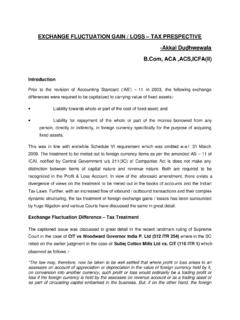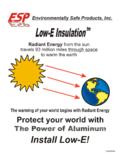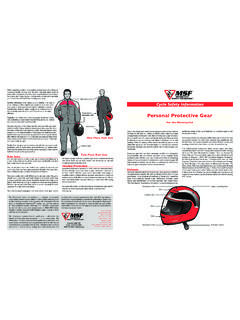Transcription of UNDERSTANDING RETROREFLECTIVITY A brief …
1 UNDERSTANDING RETROREFLECTIVITY2 DESIGNING SAFER ROADSIDESA brief history ofretroreflective sign facesheet materialsTHE PRINCIPLES OF RETROREFLECTIONR etroreflection (reflecting light back towards its source)uses three basic principles:a)specular reflection (as from a mirror or highlypolished surface)b)refraction (the change in direction of light as it passesfrom one medium to another eg air to glass)c)total internal reflection (where light hitting thesurface of a transparent material at certain anglesbounces off the surface rather than passing throughit).
2 These principles have been well understood forhundreds of years and have been employed by everyjeweller who has cut and polished a gemstone. But insteadof creating multiple reflected beams, retroreflectors aredesigned to reflect only a beam of light back along thesame path as the incoming beam. There are two basicoptical systems of RETROREFLECTIVITY and these are shown inFigure Glass Sphere or BeadThe simplest retroreflector is a glass sphere or bead. Whena light beam is directed at it, the majority of the lightbounces off it but a significant amount passes through thefront surface (facing the light source)
3 And is bent orrefracted roughly towards the centre of the rear light hitting the rear surface of the sphere isinternally reflected back through the front surface of thesphere face and is again refracted onto a course parallel tothe direction from which it 28% of the area of the sphere is at a sufficientlyfavourable angle to return the light beam and there arelosses every time the light encounters a surface of theglass, especially when the beam hits the rear wall where alarge proportion passes through it rather than beinginternally reflected.
4 A major improvement in retroreflec-tivity can therefore be achieved by coating the sphere srear surface so that it acts as a mirror (as shown in Figure 2,below). Prismatic or Cube Corner ReflectorMore efficient is the prismatic or cube-corner reflector. Ifyou take a solid glass cube and slice off one corner with acut that passes along the diagonals of three adjoining facesyou have the basic cube-corner unit which is a squattriangular pyramid shaped prism. When the pyramid is setup with the triangular base directed towards a beam oflight, the light passes through the base with very little inside the pyramid it is internally reflected off eachof the three side faces in turn before being directed backthrough the base, exiting parallel to the incoming light is still parallel to the incoming beameven when the incoming beam is not square to the face ofJohn Lloyd explains the principles of retroreflection.
5 Gives a brief history of the technology and takes a look at whatwe might expect in the 1: The two systems ofoptical retroflectivitythe pyramid, as the light is equally refracted whenentering and leaving the prism. The cube-corner pyramid prism is a fairly efficientretroreflector but has two limitations:a)Light entering close to the corners of the triangularbase is only internally reflected off the two nearestsides and misses the third side, which is too far 35% of the incoming light is lost in this )As the angle at which the light approaches the entryface becomes shallower, so an increasing proportionof the light will bounce off the surface instead ofentering the pyramidal prism.
6 These losses are rela-tively small where the light hits it within 10 to 15 ofsquare but rapidly increase at more acute the reflective faces of the prism are polished,accurate and perfectly clean, then total internal reflectionis achieved when the incoming light hits them but dirtysurfaces result in much increased light leakage . Vacuummetallization of these rear surfaces resolves the cleanlinessissue but, surprisingly, a plain pristine surface is slightlymore efficient than a mirrored surface in reflecting light. Characteristically, spherical retroreflectors have lowerperformance but maintain it over a wide range of lightingincidence angles whereas prismatic retroreflectors aremuch brighter when lit close to head on but performworse than the spherical reflectors at wider angles ofincidence (a sphere presents the same geometry irre-spective of the direction of the beam).
7 However, triangular pyramid bases can fit snuglytogether to form a continuous surface, gathering andreturning the incoming light, whereas there are inevitablygaps between glass spheres (comprising about 25% of thetotal area). Even so, mass producing glass spheres is verymuch easier than making pyramids with accurate, highlypolished facets!The Addition of RETROREFLECTIVITY to Traffic SignsRetroreflective sign faces typically employ one or theother of these two simple systems. However, creating largeretroreflective sign faces that are both highly and evenlyreflective, durable and commercially viable, has been farfrom simple and improvements are still ongoing after 80years of the 1920s relatively large glass spheres (10mm to20mm in diameter) were attached to signs to outline theprincipal symbols.
8 In parallel cube-corner elements wereproduced as glass mouldings for similar purposes butagain the individual cube corner pyramids were quitelarge (in the order of 6mm across). Modern sign faces,however, have their roots in the miniaturisation of thesetwo retroreflective DEVELOPMENT OF RETROREFLECTIVESHEETING USING GLASS BEADSIn the1930 s the American company, Potters, made tinyaccurate glass spheres or beads only a fraction of amillimetre in diameter which were first used on thecinema s silver screens giving a much brighter were made to reflectorize road markings andtraffic signs by sprinkling these beads onto a layer of wetpaint or adhesive.
9 In 1937 3M developed a retroreflective tape with asurface layer of glass beads for bonding to the road surfacebut after durability problems, this development effort wasswitched to vertical road trials of sign faces with a layer of beads applied totheir surfaces produced retroreflective results, butbrightness was low by current standards. The exposed or open beads lost all reflectivity in heavy rain, as the filmof water deflected the light, and dirt collected in the tinycrevices between the beads. However, 3M then applied afacing layer of transparent plastic to the open face of thebeads so that it filled the crevices between them andproduced a smooth glossy top surface.
10 This flat-top system was produced in the form of a flexible sheetingcomprising a carrier film backed with a mountingadhesive and faced with a layer of silver/white beadadhesive into which a layer of glass beads was impressedto about half the diameter of the beads with a final trans-parent face layer covering the front half of the beads. Thebeads were thus enclosed within the composite sheeting. While the white/silver bead adhesive had only limitedspecular reflective properties it reduced the loss of lightthat would otherwise have taken place at the rear face ofthe beads boosting their retroreflective performance.







